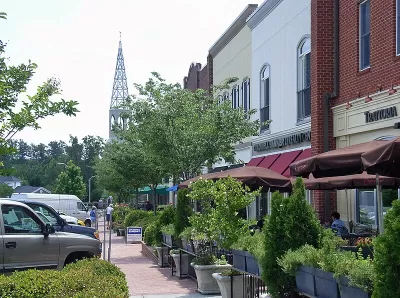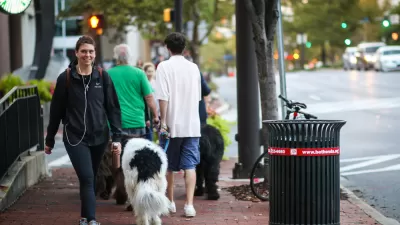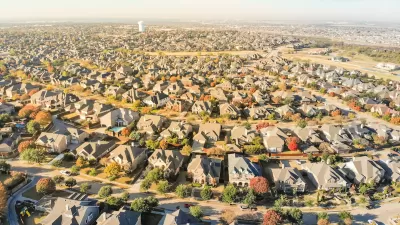I visited three New Urbanist developments in North Carolina. Here's what I liked, what I didn't like, and what I learned.

Earlier this month, I went to Charlotte, North Carolina for the CNU (Congress for the New Urbanism) conference, and then visited Chapel Hill (as well as Raleigh and Durham nearby) for a day and a half. During this trip I saw three New Urbanist developments: Birkdale Village in the Charlotte suburbs, and Meadowmont Village and Southern Village on the outskirts of Chapel Hill. All three were of course more walkable than a typical suburb, but their weaknesses illustrate the challenges that New Urbanism faces in an extremely car-oriented metro area such as Charlotte or Raleigh.
Birkdale was the most visually exquisite of the three developments: the main street encircles a village green surrounded by buildings with shops on the first floor and apartments on the second. Often, parks aren’t that visually appealing; many American parks are just a field with a few trees and benches. But this was not true in Birkdale: the park had lots of small structures other than furniture, such as a tiny restaurant and public restrooms that were newer and more ornate than a typical park restroom. More importantly, the park seemed broken up into multiple segments, thus making it look less monotonous than a typical park. Outside the main street, there was a block or two of shopping streets in any direction. So one lesson of Birkdale is: divide parks into enough segments so that they don’t look boring.
On the outskirts of Birkdale were “big box” stores with a lot of parking. If you traveled more than a block or two to the south of the village green, you got to see something that looked like conventional suburbia. On the positive side, this means that inhabitants of Birkdale got access to large-scale shops. Even though the large parking lots made the southern blocks less pleasant for pedestrians than the village green, their segregation from the main street meant that Birkdale inhabitants at least were able to experience a few super-walkable, visually appealing shopping blocks. (There were apparently single-family homes north of the shopping street but I don't think they are part of the development, and because I was on an organized CNU tour I did not have time to see them).
After CNU, I visited Chapel Hill. The first Chapel Hill development I saw was Meadowmont Village. On the positive side, Meadomont’s natural attractions were more visible than those of Birkdale; I saw a trail or two that were within a short walk of Meadowmont shops. There was a tiny walkable shopping street. However, cars seemed to be far more dominant than in Birkdale. The streets seemed a bit wider, and parking lots were far more visible. Meadowmont seems to have more houses and fewer apartments than Birkdale. I got the impression that the developers were trying to create a combination of conventional suburbia and New Urbanism. In most directions, the development was only a block or two from high-speed roads. As a result, it seemed to me that one could have a short and interesting walk through Meadowmont, or a long and boring one.
Then I visited Southern Village. Like Birkdale, Southern Village had a village green surrounded by stores. The main street that included the village green seemed narrower and more walkable than most streets in Meadowmont. The village green was divided into two parts: a small park that looked moderately attractive, and surface parking (which seems slightly less intrusive than in Meadowmont, perhaps because it was fenced off and surrounded by shrubbery). I liked the residential blocks in Southern Village; different types of housing were intermingled, so it was a bit less monotonous than a typical suburb. By contrast, in Birkdale and Meadowmont, the apartments seems more segregated from the houses.
According to Wikipedia, Southern Village includes over 300 acres, while Meadowmont has only 27 and Birkdale Village had only 52. This fact may illustrate why Southern Village seemed less constrained by high-speed roads than Meadowmont: its developers simply had more land to work with.
It seems to me that all three developments had some areas that were more pleasant for pedestrians for a typical suburb; however, all three struggled with parking in different ways. In a car-dependent metro, a development that wishes to attract motorists from other neighborhoods to its shops has three options. First, it can make car parking less visible by building garages—but this is more expensive than surface parking, and thus rarely popular where land is cheap. Second, it can place parking in the middle of the development, as occurred in Meadowmont and Southern Village. This option makes the development less attractive for pedestrians, especially compared to downtown Chapel Hill, where parking is far less visible. Third, it can shift surface parking to the edge of the development, as occurred in Birkdale. The downside of this strategy is that it means drivers might have to walk a few blocks to the stores on the main street, so I’m not sure it works unless there are at least a few big-box stores near the parking (as was the case in Birkdale).

Manufactured Crisis: Losing the Nation’s Largest Source of Unsubsidized Affordable Housing
Manufactured housing communities have long been an affordable housing option for millions of people living in the U.S., but that affordability is disappearing rapidly. How did we get here?

Americans May Be Stuck — But Why?
Americans are moving a lot less than they once did, and that is a problem. While Yoni Applebaum, in his highly-publicized article Stuck, gets the reasons badly wrong, it's still important to ask: why are we moving so much less than before?

Using Old Oil and Gas Wells for Green Energy Storage
Penn State researchers have found that repurposing abandoned oil and gas wells for geothermal-assisted compressed-air energy storage can boost efficiency, reduce environmental risks, and support clean energy and job transitions.

Updating LA’s Tree Rules Could Bring More Shade to Underserved Neighborhoods
A new USC study finds that relaxing Los Angeles’ outdated tree planting guidelines could significantly expand urban tree canopy and reduce shade disparities in lower-income neighborhoods, though infrastructure investments are also needed.

California's Canal Solar Projects Aim to Conserve Resources and Expand Clean Energy
California’s Project Nexus has begun generating electricity from solar panels installed over irrigation canals, with researchers and state agencies exploring statewide expansion to conserve water and boost clean energy production.

HHS Staff Cuts Gut Energy Assistance Program
The full staff of a federal program that distributes heating and cooling assistance for low-income families was laid off, jeopardizing the program’s operations.
Urban Design for Planners 1: Software Tools
This six-course series explores essential urban design concepts using open source software and equips planners with the tools they need to participate fully in the urban design process.
Planning for Universal Design
Learn the tools for implementing Universal Design in planning regulations.
Heyer Gruel & Associates PA
City of Moreno Valley
Institute for Housing and Urban Development Studies (IHS)
City of Grandview
Harvard GSD Executive Education
Salt Lake City
NYU Wagner Graduate School of Public Service
City of Cambridge, Maryland





























